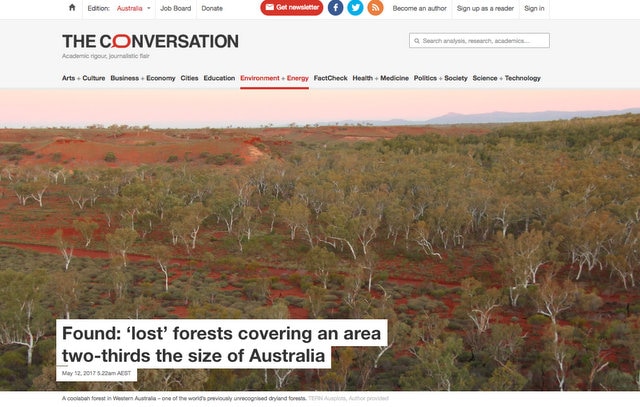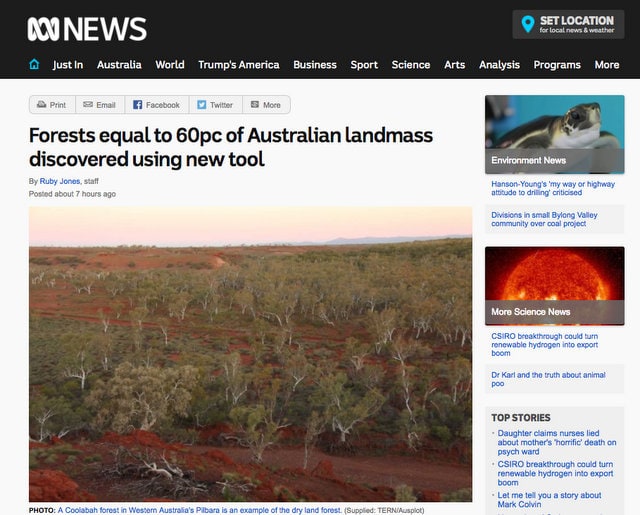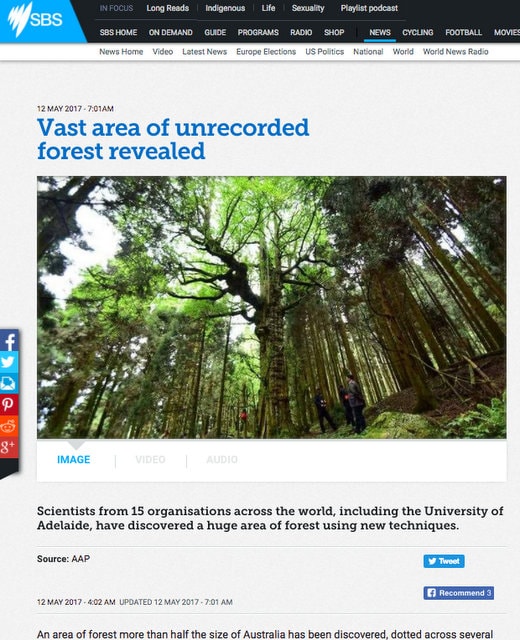A global analysis of the distribution of forests and woodlands across dryland ecosystems using TERN data has increased current estimates of global forest cover by nearly 10%.
The work, now published in Science, is a direct result of TERN’s on-going collaborations with the United Nation’s Food and Agriculture Organization through their Global Forest Survey, which uses TERN environmental monitoring sensors for crucial on-ground verification of satellite-based analyses.
An innovative new analysis of global drylands using high-resolution satellite imagery has ‘found’ 467 million hectares of previously unreported forest—an area equivalent to 60% of the size of Australia.
Finding these lost dryland forests increases current estimates of global forest cover by almost 10%, and by approximately 45% for dryland forest types.
These results, just published in Science, are set to drastically improve the accuracy of global models of terrestrial carbon sinks and carbon inventories submitted under international climate conventions including the UNFCCC and the Kyoto Protocol.
Moreover, by revealing that drylands—which make up about 40% of Earth’s land surface—have a greater capacity to support trees and forest than previously perceived and understood, a unique chance to mitigate climate change impacts through large-scale dryland conservation and afforestation actions is presented.
The research, conducted by an international team of scientists from The Food and Agriculture Organization of the United Nations (FAO), the University of Adelaide, TERN and a dozen other public and private institutions from all continents, stems from the FAO’s Global Drylands Assessment phase of the Global Forest Survey.
The team analysed very high spatial and temporal resolution satellite imagery of more than 210,000 dryland monitoring plots to calculate global forest cover and its change over time. TERN’s national network of over 500 ecosystem observation plots and the field data collected at them were used to complete the Oceania component of the study.
The resources provided by TERN are the only global plot-based data source readily available and accurate enough to validate satellite imagery, verify the observed density of trees, and assess observer accuracy. In fact, TERN ecosystem observation plots are so vital to the project that the FAO is working on permanently incorporating them into their global forest-monitoring network.

The TERN-facilitated global drylands forest project made the cover of Science Magazine
(12 MAY 2017, VOL 356, ISSUE 6338)
Project member Danilo Mollicone of the FAO said the decision to use TERN infrastructure and expertise was made thanks to TERN’s proven expertise and research infrastructure in Australia’s arid ecosystems.
“TERN’s infrastructure and expertise is vital to the FAO and the successful completion of our Global Drylands Assessment,” says Danilo.
“The data we collect via TERN fills an important information gap that ensures the project has worldwide coverage. With such global coverage we were able to accurately obtain estimates on tree cover, forest extension and land use in the drylands.”
“Over time, our ongoing partnership with TERN, will also help the project identify spatial and temporal changes and trends within ecosystems and between continents as biological and non-biological influences come into play.”
Associate Professor Ben Sparrow of the University of Adelaide and TERN AusPlots, led Australia’s involvement in the project and seconds Danillo’s call for ongoing monitoring.
“Dryland forests play an increasingly important role in preventing desertification, maintaining livelihoods and mitigating the impacts of climate change at regional and global scales, so it’s vital that we continue to monitor the long-term trends in dryland forest cover and quality,” says Ben.
TERN looks forward to further strengthening our relationship with the FAO and continuing to provide the infrastructure, data and expertise required to complete this ongoing study that has already delivered such positive and timely global outcomes for our ecosystems.
- Vast amounts of data on Australia's arid ecosystems, including vegetation and soil from over 500 sites, are now openly available via the TERN Data Discovery Portal.
- Just like the data we make openly accessible, TERN's research infrastructure is open for all to use. If you'd like to make the most of our infrastructure or expertise please get in touch.










